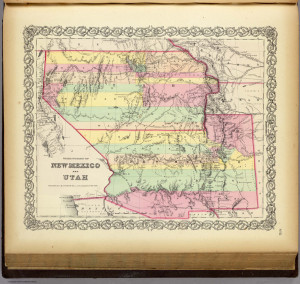Normally New Mexico points to Mississippi as the negative example keeping us from being the bottom feeder of all manner of quality-of-life rankings. When a Republican legislator who didn’t get New Mexico’s Latin state motto tried to change it, the derisive reaction included jettisoning “Crescit Eundo” in favor of “Gracias a dios por Mississippi.” That’s all just noise, of course, which doesn’t obviate our beloved and beautiful state being worst in the nation for child well-being after Mississippi moved up to 49th in the Kids Count Data Book last year.
Now, however, it’s time to thank Arizona for reminding us what’s right in New Mexico. Yes, Gov. Jan Brewer yesterday vetoed the bill enshrining as public policy religious discrimination against gays and anyone else, but students of New Mexico history recognize our neighbor’s roots running deep into the 19th century. There, but for the grace of politics and the Spanish language, our two states would look like today’s Republican Party, a single body enjoined in a fight for its soul between panicked moderates and snarling radicals.
To understand this requires a rapid and much simplified recap of local history:

Amtrak’s Sunset Limited crosses the Rio Grande from El Paso, Texas, into New Mexico nearly on the Mexican border. Bill Diven photo.
The United States, for myriad reasons — Manifest Destiny, spreading slavery, lust for a rail route to California — invaded Mexico in 1846. Two years later we owned the Southwest, or thought we did. We botched the survey drawing the border too far north for the rail route, but instead of sending the dragoons back in, we bought what is now much of southern New Mexico and Arizona.
Military governance ended in 1850 with everything from Texas to California plus parts of modern Colorado, Oklahoma, Utah and Nevada becoming the Territory of New Mexico. Then came Anglo settlers and federal appointees joining some prewar residents in banging a gong for statehood. We’ll skip the complex tale of business and political interests opposing statehood to preserve their government contracts and profitable corruptions other than to note self-dealing was, and remains, well-established here.
Suffice also to say racial and religious tensions abounded, and Indian wars continued. But peeling off a few layers reveals what became our better side. The pueblo Indians organized to kick out the Spanish a couple of hundred years earlier, and when the colonizers eventually returned it was with some touch of humility. Otherwise we wouldn’t have sovereign pueblos in our modern mix. The Navajo, Apache and Ute peoples suffered badly but to some degree reclaimed native lands when peace came. And the Spanish language remained so pervasive an Anglo newcomer hoping for any success learned it and showed respect for established traditions. Even now politicians ignore those traditions and campaign protocols at their risk. Witness Texas transplant and Gov. Susana Martinez attending a matanza in Albuquerque’s South Valley last month in appropriate attire but not participating in using the proper wooden paddle to stir the bubbling pot of chicarrones.

Territories of New Mexico and Utah, J.H. Colton, New York, 1856. From the David Rumsey Historical Map Collection, Cartography Associates, under Creative Commons license.
But not in Arizona. Split off as its own territory during the Civil War, it enjoyed a national image of great potential wealth, which brought all manner of immigrants from the established states and elsewhere. It also lacked the extensive Spanish settlement found in New Mexico and California. The clamor for statehood there is another complicated tale of fits, starts and backstabbings as one attempt after another failed to bring either territory into the United States.
And that brings us to the earliest 1900s and the bright idea in Congress to merge the two territories into a single new state more than half the size of Europe. That set off fireworks all around as neither Hispanic New Mexico nor Anglo Arizona wanted to cuddle up to the other.
Differences in the people of the two territories and their contrasting backgrounds were brought out during the controversy. New Mexico’s predominantly Spanish-speaking population and Arizona’s Anglo majority seemed to many an incompatible combination. One newspaper crudely referred to the citizens of New Mexico as a mongrel population too ignorant and lazy to assume the privileges of full citizenship. (Larson, Robert W., New Mexico’s Quest for Statehood 1846-1912, The University of New Mexico Press, Albuquerque, N.M., 1968, p. 244.)
The arranged marriage never happened with Arizonans voting 5-1 against joint statehood on Election Day 1906 as New Mexicans voted 2-1 in favor. Don’t read too much into New Mexico’s vote, however. Everyone expected Arizona to reject the idea, so New Mexico leaders campaigned for yes votes in a movida intended to curry favor with President Teddy Roosevelt and his allies in Congress. Arizona and we both got what we wanted and separately joined the union in 1912.
One of the great things about New Mexico history is that it’s not history, it’s current events. When an Anglo umpire threatened to eject high school ballplayers and coaches for speaking Spanish during a game last year, he ignited a firestorm. The state prep-sports association noted there was no rule against it, and everyone got a lesson in the state Constitution, which protects the Spanish language. The baseball team, by the way, was from Gadsden High School located in that piece of Old Mexico we bought after the Mexican War.
Since statehood we’ve not been immune to our own intolerances from separate schools for African-Americans to denying Native Americans the right to vote and businesses across the Southwest posting signs saying “No dogs and no Mexicans allowed.” To profess we’re free of prejudice today would not be realistic. But taken as a whole, we’ve done pretty well. So thank you, Arizona, for another reminder of what New Mexico is and is not.

